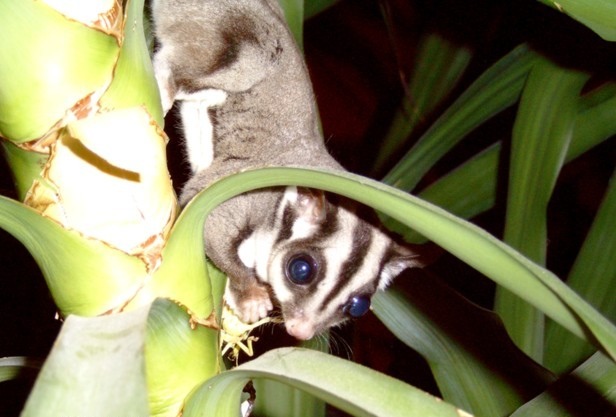|
| 질의: caterpillar | 결과: 1164번째/1696 | |
Family: Petauridae (possums) - Wiki
| 제목: | Family: Petauridae (possums) - Wiki
| |

| 해상도: 616x417
파일크기: 91286 Bytes
등록시간: 2007:12:18 17:06:22
|
Petauridae
From Wikipedia, the free encyclopedia
Scientific classification
Kingdom: Animalia
Phylum: Chordata
Class: Mammalia
Infraclass: Marsupialia
Order: Diprotodontia
Superfamily: Petauroidea
Family: Petauridae
[Photo] Sugar Glider, Petaurus breviceps. Sugarglider, Kurzkopfgleitbeutler. Source: Anke Meyring - www.beepworld.de/members72/nightshade77/sugarglider.htm
The family Petauridae includes 11 medium-sized possum species: four striped possums, the six species wrist-winged gliders in genus Petaurus, and Leadbeater's Possum which has only vestigal gliding membranes. Most of the wrist-winged gliders are native to Australia, most of the striped possums (genus Dactylopsila) to New Guinea, but some members of each are found on both sides of Torres Strait.
All petaurids have obvious facial markings, a well-defined dorsal stripe, very large lower front incisors, and four-cusped molars. Despite their distinctive appearance, petaurids are closely related to the ringtailed possums (family Pseudocheiridae) and are grouped together with them to form the superfamily Petauroidea.
The wrist-winged gliders are omnivorous, specialising on sap and nectar, but taking a wide variety of supplemental foods. The gliders appears to have evolved in the open forests of Australia???gliding membranes are an adaptation which aids mobility when the forest canopy is incomplete, and are of little use in rainforests??? but now has representatives in New Guinea and many of the smaller islands nearby. Their similarities to the unrelated flying squirrels are an example of convergent evolution.
The striped possums (trioks), on the other hand, are thought to have evolved on New Guinea, and the sole Australian species (the Striped Possum of Cape York) is considered a recent immigrant. All members of this genus are insectivores, and have specalised structures for catching insects: a heel-like structure on the wrist that is thought to be used to tap on wood to locate insect larvae. and an elongated fourth finger to extract them from their burrows.
Classification
Genus Dactylopsila
Great-tailed Triok, Dactylopsila megalura
Long-fingered Triok, Dactylopsila palpator
Tate's Triok, Dactylopsila tatei
Striped Possum, Dactylopsila trivirgata
Genus Gymnobelideus
Leadbeater's Possum, Gymnobelideus leadbeateri
Genus Petaurus
Northern Glider, Petaurus abidi
Yellow-bellied Glider, Petaurus australis
Biak Glider, Petaurus biacensis
Sugar Glider, Petaurus breviceps
Mahogany Glider, Petaurus gracilis
Squirrel Glider, Petaurus norfolcensis
http://en.wikipedia.org/wiki/Petauridae
| The text in this page is based on the copyrighted Wikipedia article shown in above URL. It is used under the GNU Free Documentation License. You may redistribute it, verbatim or modified, providing that you comply with the terms of the GFDL. |
|
^o^
동물그림창고 똑똑전화 누리집
^o^
|
|